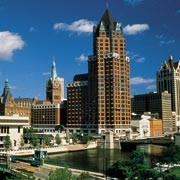For anyone who’s never been to Milwaukee or hasn’t visited recently, “jewel-like” might not come to mind as an apt description of a city historically known for beer, brats, Harleys, and the strong personalities of Shotz Brewery bottle-cappers Laverne and Shirley.
“We either have no image or an antiquated 1950s sitcom image, but when people get off the plane, they’re just blown away,” says Jack Moneypenny, vice president of sales for Visit Milwaukee. “They say, “You’ve got to tell people this is the best-kept secret of the Midwest.”
What a difference a decade makes. Sure, you can still hear the rumble of the Harleys and savor some of the best hops and juiciest German sausages, but nowadays, classic Milwaukee mingles with cosmopolitan Milwaukee and its sophisticated arts, culture and dining scene, not to mention its increasingly “green” mindset.
“It goes back to 1998 when the convention center opened, and since then we’ve had $2.5 billion in new tourism product,” Moneypenny says, pointing to important developments such as the Milwaukee Brewers’ new home, Miller Park, with its retractable roof, and the super mod, lakeside addition to the Milwaukee Art Museum, Spanish architect Santiago Calatrava’s Burke Brise Soleil, a gleaming white, phoenix-like structure that has become a city icon.
Burke Brise Soleil was the catalyst for further development along Lake Michigan, including the impressive new Discovery World at Pier Wisconsin, focusing on science, technology and marine life.
“Probably the granddaddy of them all is the Harley-Davidson Museum, which opens in 2008 on 22 acres in the valley and will be able to handle up to 20,000 people for an event,” Moneypenny says.
Downtown’s convenient, walkable layout, complemented by the 3.5-mile, expanding Riverwalk, featuring shops, restaurants and other waterside lures, is another surprise, in addition to the ethnic diversity reflected in Milwaukee’s dining options and eclectic neighborhoods, according to Moneypenny.
“Downtown is really a culmination of neighborhoods,” he says. “There’s historic Third Ward, housing antique shops, the public market and lofts converted from old buildings; Upper East Side; Lower East Side; Brady Street; East Town; West Town; and Walker’s Point, an Hispanic district that is developing the Latin Quarter, reminiscent of the French Quarter in New Orleans, with music, food and entertainment.”
Not that the city doesn’t already know how to entertain itself; the 10-day, lakefront Summerfest, the “World’s Largest Music Festival,” celebrated its 40th anniversary this year, and a different ethnic festival (Irish, Italian, Greek, and African, among many others) takes place every weekend during the summer.
While the city’s vibrant, friendly atmosphere and stellar lineup of attractions, group venues and hotels are premier selling points, the crown jewel is its natural resources, according to Moneypenny.
“So many people see us as an old industrial city, and when they get here they find parkland—five or six parks right downtown—and 22 miles of shoreline that is open to the public,” Moneypenny says. “The face of our city looks out over Lake Michigan, the largest of the Great Lakes; our access to water and green space really sets us apart.”







